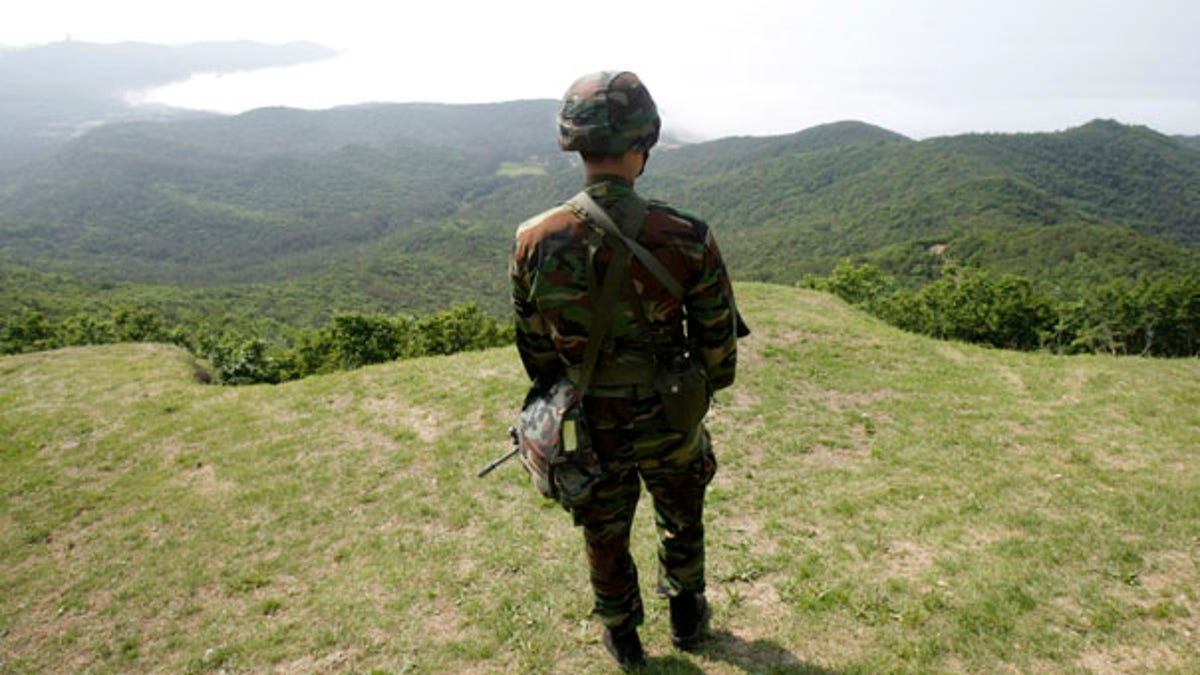
June 15: A South Korean Marine looks across the border into North Korea as he stands guard on Baengnyeong Island, South Korea. (AP)
SEOUL, South Korea -- Abnormally high radiation levels were detected near the border between the two Koreas days after North Korea claimed to have mastered a complex technology key to manufacturing a hydrogen bomb, Seoul said Monday.
The Science Ministry said its investigation ruled out a nuclear test by North Korea, but failed to determine the source of the radiation. It said there was no evidence of a strong earthquake, which follows an atomic explosion.
On May 12, North Korea claimed its scientists succeeded in creating a nuclear fusion reaction -- a technology necessary to manufacture a hydrogen bomb. In its announcement, the North did not say how it would use the technology, only calling it a "breakthrough toward the development of new energy."
South Korean experts doubted the North actually made such a breakthrough. Scientists around the world have been experimenting with fusion for decades, but it has yet to be developed into a viable energy alternative.
On May 15, however, the atmospheric concentration of xenon -- an inert gas released after a nuclear explosion or and radioactive leakage from a nuclear power plant -- on the South Korean side their shared border was found to be eight times higher than normal, according to South Korea's Science Ministry.
South Korea subsequently looked for signs of a powerful, artificially induced earthquake. Experts, however, found no signs of a such a quake in North Korea, a ministry statement said.
"We determined that there was no possibility of an underground nuclear test," it said. The ministry said the gas is not harmful.
While any fusion test would have registered seismic activity, according to nuclear expert Whang Joo-ho of South Korea's Kyung Hee University, the presence of xenon could also have come from a leak.
Since the wind was blowing from north to south when the xenon was detected, a Science Ministry official said the gas could not have originated from any nuclear power plants in South Korea.
But the official -- speaking on condition of anonymity, citing department policy -- said the xenon could have come from Russia or China. Whang agreed, saying a nuclear test or radioactive leakage would be the only reasons that could explain the atmospheric concentration of xenon reported by the ministry.
A Vienna-based United Nations agency, however, said no signs of increased radioactivity were detected last month along the Korean border.
"We have not registered anything that would raise any suspicion," said Kirsten Haupt, a spokeswoman for the Comprehensive Test Ban Treaty Organization, a U.N. agency that looks for signs of nuclear testing worldwide.
Earlier Monday, South Korea's mass-circulation Chosun Ilbo newspaper reported that North Korea may have conducted a small-sized nuclear test, citing the abnormal radioactivity. The paper cited an atomic expert it did not identify.
North Korea -- which is believed to have enough weaponized plutonium for at least a half-dozen nuclear weapons, conducted two underground nuclear tests in 2006 and 2009, drawing international condemnation and U.N. sanctions.
The news of the detected radiation comes as tension is running high on the Korean peninsula over the deadly sinking of a South Korean warship blamed on a North Korean torpedo attack. North Korea flatly denies the allegation and has warned any punishment would trigger war, as the U.N. Security Council reviews Seoul's request for action over the sinking.
